Street Vibrancy and Outdoor Activities under COVID-19 Psychological Distress: Lessons from Hong Kong
Abstract
:1. Introduction
1.1. Outdoor Activities for Psychological Health
1.2. The Hong Kong Case
1.3. Outdoor Activities as Volitional Behaviors, a Decision-Making Perspective
1.4. Research Aim
2. Materials and Methods
Data Collection and Processing
3. Results
3.1. Activity Density Dispersion
3.2. Activities Related to Mini-Bus and MTR
3.3. Spatial Correlation of Anchor Parcels Related to Outdoor Activities
4. Discussion
5. Conclusions
Author Contributions
Funding
Data Availability Statement
Acknowledgments
Conflicts of Interest
References
- Campion, J.; Javed, A.; Sartorius, N.; Marmot, M. Addressing the public mental health challenge of COVID-19. Lancet Psychiatry 2020, 7, 657–659. [Google Scholar]
- Cullen, W.; Gulati, G.; Kelly, B.D. Mental health in the COVID-19 pandemic. QJM Int. J. Med. 2020, 113, 311–312. [Google Scholar] [CrossRef]
- Usher, K.; Durkin, J.; Bhullar, N. The COVID-19 pandemic and mental health impacts. Int. J. Ment. Health Nurs. 2020, 29, 315. [Google Scholar]
- Xiang, Y.-T.; Yang, Y.; Li, W.; Zhang, L.; Zhang, Q.; Cheung, T.; Ng, C.H. Timely mental health care for the 2019 novel coronavirus outbreak is urgently needed. Lancet Psychiatry 2020, 7, 228–229. [Google Scholar] [CrossRef]
- Xiong, J.; Lipsitz, O.; Nasri, F.; Lui, L.M.W.; Gill, H.; Phan, L.; Chen-Li, D.; Iacobucci, M.; Ho, R.; Majeed, A.; et al. Impact of COVID-19 pandemic on mental health in the general population: A systematic review. J. Affect. Disord. 2020, 277, 55–64. [Google Scholar] [CrossRef]
- Zhang, J.; Lu, H.; Zeng, H.; Zhang, S.; Du, Q.; Jiang, T.; Du, B. The differential psychological distress of populations affected by the COVID-19 pandemic. Brain Behav. Immun. 2020, 87, 49. [Google Scholar]
- Drapeau, A.; Marchand, A.; Beaulieu-Prevost, D. Epidemiology of psychological distress. Ment. Illnesses-Underst. Predict. Control. 2012, 69, 105–106. [Google Scholar]
- Horwitz, A.V. Distinguishing distress from disorder as psychological outcomes of stressful social arrangements. Health 2007, 11, 273–289. [Google Scholar]
- Ridner, S.H. Psychological distress: Concept analysis. J. Adv. Nurs. 2004, 45, 536–545. [Google Scholar]
- Chaix, B.; Delamon, G.; Guillemassé, A.; Brouard, B.; Bibault, J.-E. Psychological distress during the COVID-19 pandemic in France: A national assessment of at-risk populations. Gen. Psychiatry 2020, 33, 6. [Google Scholar]
- Qiu, J.; Shen, B.; Zhao, M.; Wang, Z.; Xie, B.; Xu, Y. A nationwide survey of psychological distress among Chinese people in the COVID-19 epidemic: Implications and policy recommendations. Gen. Psychiatry 2020, 33, 2. [Google Scholar]
- Wise, T.; Zbozinek, T.D.; Michelini, G.; Hagan, C.C.; Mobbs, D. Changes in risk perception and self-reported protective behaviour during the first week of the COVID-19 pandemic in the United States. R. Soc. Open Sci. 2020, 7, 200742. [Google Scholar]
- Pfefferbaum, B.; North, C.S. Mental Health and the COVID-19 Pandemic. N. Engl. J. Med. 2020, 383, 508–510. [Google Scholar] [CrossRef]
- World Health Organization. Severe Acute Respiratory Syndrome (SARS)-Multi-Country Outbreak—Update 49. 2003. Available online: https://www.who.int/emergencies/disease-outbreak-news/item/2003_05_07a-en (accessed on 1 September 2020).
- United Nations, Department of Economic and Social Affairs Population Division. World Population Prospects 2022, Online Edition. 2022. Available online: https://population.un.org/wpp/Download/Standard/MostUsed/ (accessed on 1 January 2023).
- McBride-Chang, C.; Cho, J.-R.; Liu, H.; Wagner, R.K.; Shu, H.; Zhou, A.; Cheuk, C.S.; Muse, A. Changing models across cultures: Associations of phonological awareness and morphological structure awareness with vocabulary and word recognition in second graders from Beijing, Hong Kong, Korea, and the United States. J. Exp. Child Psychol. 2005, 92, 140–160. [Google Scholar]
- Zacharias, J. Pedestrian dynamics on narrow pavements in high-density Hong Kong. J. Urban Manag. 2021, 10, 409–418. [Google Scholar] [CrossRef]
- Chow, J. Public Open Space Accessibility in Hong Kong: A Geospatial Analysis. 2018. Available online: https://www.researchgate.net/publication/328482653_Public_Open_Space_Accessibility_in_Hong_Kong_A_Geospatial_Analysis (accessed on 1 September 2020). [CrossRef]
- Lai, C. Unopened Space: Mapping Equitable Availability of Open Space in Hong Kong; Civic Exchange: Hong Kong, China, 2017. [Google Scholar]
- Wicks, C.; Barton, J.; Orbell, S.; Andrews, L. Psychological benefits of outdoor physical activity in natural versus urban environments: A systematic review and meta-analysis of experimental studies. Appl. Psychol. Health Well-Being 2022, 14, 1037–1061. [Google Scholar] [CrossRef]
- Buchecker, M.; Degenhardt, B. The effects of urban inhabitants’ nearby outdoor recreation on their well-being and their psychological resilience. J. Outdoor Recreat. Tour. 2015, 10, 55–62. [Google Scholar] [CrossRef]
- Wolsko, C.; Lindberg, K. Experiencing Connection With Nature: The Matrix of Psychological Well-Being, Mindfulness, and Outdoor Recreation. Ecopsychology 2013, 5, 80–91. [Google Scholar] [CrossRef]
- Johansson, M.; Hartig, T.; Staats, H. Psychological Benefits of Walking: Moderation by Company and Outdoor Environment: Environmental Moderation of Walking Benefits. Appl. Psychol. Health Well-Being 2011, 3, 261–280. [Google Scholar] [CrossRef]
- Weng, P.-Y.; Chiang, Y.-C. Psychological Restoration through Indoor and Outdoor Leisure Activities. J. Leis. Res. 2014, 46, 203–217. [Google Scholar] [CrossRef]
- Bustamante, G.; Guzman, V.; Kobayashi, L.C.; Finlay, J. Mental health and well-being in times of COVID-19: A mixed-methods study of the role of neighborhood parks, outdoor spaces, and nature among US older adults. Health Place 2022, 76, 102813. [Google Scholar] [PubMed]
- Beall, J.M.; Jackson, S.B.; Casola, W.R.; Peterson, M.N.; Larson, L.R.; Stevenson, K.T.; Seekamp, E. Self-reported participation in outdoor and nature-based recreation before and during the COVID-19 pandemic supports psychological health and well-being. Wellbeing Space Soc. 2022, 3, 100094. [Google Scholar] [PubMed]
- Hillier, B.; Penn, A.; Hanson, J.; Grajewski, T.; Xu, J. Natural movement: Or, configuration and attraction in urban pedestrian movement. Environ. Plann. B 1993, 20, 29–66. [Google Scholar] [CrossRef]
- Kuo, F.E.; Sullivan, W.C.; Coley, R.L.; Brunson, L. Fertile Ground for Community: Inner-City Neighborhood Common Spaces. Am. J. Community Psychol. 1998, 26, 823–851. [Google Scholar] [CrossRef]
- Peng, Y.; Feng, T.; Timmermans, H. A path analysis of outdoor comfort in urban public spaces. Build. Environ. 2019, 148, 459–467. [Google Scholar] [CrossRef]
- Addy, C.L.; Wilson, D.K.; Kirtland, K.A.; Ainsworth, B.E.; Sharpe, P.; Kimsey, D. Associations of Perceived Social and Physical Environmental Supports with Physical Activity and Walking Behavior. Am. J. Public Health 2004, 94, 440–443. [Google Scholar] [CrossRef]
- Sugiyama, T.; Thompson, C.W. Outdoor Environments, Activity and the Well-Being of Older People: Conceptualising Environmental Support. Environ. Plan A 2007, 39, 1943–1960. [Google Scholar] [CrossRef]
- Roe, J.; Mondschein, A.; Neale, C.; Barnes, L.; Boukhechba, M.; Lopez, S. The Urban Built Environment, Walking and Mental Health Outcomes among Older Adults: A Pilot Study. Front. Public Health 2020, 8, 575946. [Google Scholar] [CrossRef]
- Titze, S.; Stronegger, W.; Owen, N. Prospective study of individual, social, and environmental predictors of physical activity: Women’s leisure running. Psychol. Sport Exerc. 2005, 6, 363–376. [Google Scholar] [CrossRef]
- Owen, N.; Humpel, N.; Leslie, E.; Bauman, A.; Sallis, J.F. Understanding environmental influences on walking: Review and research agenda. Am. J. Prev. Med. 2004, 27, 67–76. [Google Scholar]
- Saelens, B.E.; Sallis, J.F.; Frank, L.D. Environmental correlates of walking and cycling: Findings from the transportation, urban design, and planning literatures. Ann. Behav. Med. 2003, 25, 80–91. [Google Scholar] [CrossRef] [PubMed]
- Pikora, T.J.; Bull, F.C.L.; Jamrozik, K.; Knuiman, M.; Giles-Corti, B.; Donovan, R.J. Developing a reliable audit instrument to measure the physical environment for physical activity. Am. J. Prev. Med. 2002, 23, 187–194. [Google Scholar] [CrossRef]
- Popkin, B.; Duffey, K.; Gordonlarsen, P. Environmental influences on food choice, physical activity and energy balance. Physiol. Behav. 2005, 86, 603–613. [Google Scholar] [CrossRef] [PubMed]
- Frank, L.D.; Engelke, P.O. The Built Environment and Human Activity Patterns: Exploring the Impacts of Urban form on Public Health. J. Plan. Lit. 2001, 16, 202–218. [Google Scholar] [CrossRef]
- Gómez-Varo, I.; Delclòs-Alió, X.; Miralles-Guasch, C. Jane Jacobs reloaded: A contemporary operationalization of urban vitality in a district in Barcelona. Cities 2022, 123, 103565. [Google Scholar]
- Guo, X.; Yang, Y.; Cheng, Z.; Wu, Q.; Li, C.; Lo, T.; Chen, F. Spatial social interaction: An explanatory framework of urban space vitality and its preliminary verification. Cities 2022, 121, 103487. [Google Scholar]
- Málovics, G.; Creţan, R.; Méreine-Berki, B.; Tóth, J. Socio-environmental justice, participatory development, and empowerment of segregated urban Roma: Lessons from Szeged, Hungary. Cities 2019, 91, 137–145. [Google Scholar]
- Park, K.; Ewing, R.; Sabouri, S.; Larsen, J. Street life and the built environment in an auto-oriented US region. Cities 2019, 88, 243–251. [Google Scholar]
- Perrone, C. ‘Downtown Is for People’: The street-level approach in Jane Jacobs’ legacy and its resonance in the planning debate within the complexity theory of cities. Cities 2019, 91, 10–16. [Google Scholar]
- Askarizad, R.; He, J. Post-pandemic urban design: The equilibrium between social distancing and social interactions within the built environment. Cities 2022, 124, 103618. [Google Scholar] [CrossRef]
- Ran, M.-S.; Gao, R.; Lin, J.-X.; Zhang, T.-M.; Chan, S.K.W.; Deng, X.-P.; Zhang, B.-Z.; Zhang, X.-F.; Huang, G.-P.; Pu, D.-S.; et al. The impacts of COVID-19 outbreak on mental health in general population in different areas in China. Psychol. Med. 2022, 52, 2651–2660. [Google Scholar] [PubMed]
- Honey-Rosés, J.; Anguelovski, I.; Chireh, V.K.; Daher, C.; Konijnendijk van den Bosch, C.; Litt, J.S.; Mawani, V.; McCall, M.K.; Orellana, A.; Oscilowicz, E.; et al. The impact of COVID-19 on public space: An early review of the emerging questions–design, perceptions and inequities. Cities Health 2021, 5, S263–S279. [Google Scholar]
- James, A.C. Don’t stand so close to me: Public spaces, behavioral geography, and COVID-19. Dialogues Hum. Geogr. 2020, 10, 187–190. [Google Scholar]
- Low, S.; Smart, A. Thoughts about public space during COVID-19 pandemic. City Soc. (Wash. DC) 2020, 32, 1. [Google Scholar] [CrossRef]
- Zordan, M.; Tsou, J.Y. Urban Transitions in Pandemic Scenarios: Insights from Hong Kong. J. Asian Behav. Stud. 2020, 5, 55–70. [Google Scholar]
- Bereitschaft, B.; Scheller, D. How might the COVID-19 pandemic affect 21st century urban design, planning, and development? Urban Sci. 2020, 4, 56. [Google Scholar]
- Tang, B. Explaining the inequitable spatial distribution of public open space in Hong Kong. Landsc. Urban Plan. 2017, 161, 80–89. [Google Scholar]
- Tieben, H. Public space trends in Hong Kong. A view from the new territories. J. Public Space 2016, 1, 25–34. [Google Scholar] [CrossRef]
- Rossini, F. Temporary urban intervention in the vertical city: A place-making project to re-activate the public spaces in Hong Kong. J. Urban Des. 2019, 24, 305–323. [Google Scholar]
- Von Schönfeld, K.C.; Bertolini, L. Urban streets: Epitomes of planning challenges and opportunities at the interface of public space and mobility. Cities 2017, 68, 48–55. [Google Scholar] [CrossRef]
- Gehl, J. Life between Buildings, 6th ed.; The Danish Architectural Press: Copenhagen, Denmark, 2011. [Google Scholar]
- Gehl, J. A changing street life in a changing society. Places 1989, 6, 1. [Google Scholar]
- Malone, K. Street life: Youth, culture and competing uses of public space. Environ. Urban. 2002, 14, 157–168. [Google Scholar]
- Burton, E.; Mitchell, L. Inclusive Urban Design: Streets for Life; Elsevier: Amsterdam, The Netherlands, 2006. [Google Scholar]
- Carmona, M.; Heath, T.; Tiesdell, S.; Oc, T. Public places urban spaces. Urban Des. Q. 2004, 90, 40. [Google Scholar]
- Mehta, V.; Bosson, J.K. Third places and the social life of streets. Environ. Behav. 2010, 42, 779–805. [Google Scholar]
- Loo, B.P.; Lam, W.W.Y. Geographic accessibility around health care facilities for elderly residents in Hong Kong: A microscale walkability assessment. Environ. Plan. B Plan. Des. 2012, 39, 629–646. [Google Scholar]
- Chen, S.; Bao, Z.; Chen, J.; Yang, L.; Lou, V. Sustainable built environment for facilitating public health of older adults: Evidence from Hong Kong. Sustain. Dev. 2022, 30, 1086–1098. [Google Scholar] [CrossRef]
- Yu, R.; Cheung, O.; Lau, K.; Woo, J. Associations between Perceived Neighborhood Walkability and Walking Time, Wellbeing, and Loneliness in Community-Dwelling Older Chinese People in Hong Kong. Int. J. Environ. Res. Public Health 2017, 14, 1199. [Google Scholar] [CrossRef]
- Ng, E. Policies and technical guidelines for urban planning of high-density cities–air ventilation assessment (AVA) of Hong Kong. Build. Environ. 2009, 44, 1478–1488. [Google Scholar]
- Xiang, L.; Cai, M.; Ren, C.; Ng, E. Modeling pedestrian emotion in high-density cities using visual exposure and machine learning: Tracking real-time physiology and psychology in Hong Kong. Build. Environ. 2021, 205, 108273. [Google Scholar] [CrossRef]
- Elsheshtawy, Y. Where the sidewalk ends: Informal street corner encounters in Dubai. Cities 2013, 31, 382–393. [Google Scholar]
- Whyte, W.H. The Social Life of Small Urban Spaces; Project for Public Spaces Inc.: New York, NY, USA, 1980. [Google Scholar]
- Gospodini, A. Urban design, urban space morphology, urban tourism: An emerging new paradigm concerning their relationship. Eur. Plan. Stud. 2001, 9, 925–934. [Google Scholar]
- Gehl, J.; Kaefer, L.J.; Reigstad, S. Close encounters with buildings. Urban Des. Int. 2006, 11, 29–47. [Google Scholar]
- Mehta, V. Lively Streets: Exploring the Relationship between Built Environment and Social Behavior; University of Maryland: College Park, MD, USA, 2006. [Google Scholar]
- Mehta, V. Lively streets: Determining environmental characteristics to support social behavior. J. Plan. Educ. Res. 2007, 27, 165–187. [Google Scholar]
- Mehta, V. Walkable streets: Pedestrian behavior, perceptions and attitudes. J. Urban. 2008, 1, 217–245. [Google Scholar]
- Mehta, V. Look closely and you will see, listen carefully and you will hear: Urban design and social interaction on streets. J. Urban Des. 2009, 14, 29–64. [Google Scholar]
- Pafka, E. Places as Intersecting Flows: Mapping Urban Morphologies, Functional Constellations and Pe-destrian Rhythms. In Proceedings of the 4th Global Conference, Space and Place, Oxford, UK, 9–12 September 2013. [Google Scholar]
- Ruiz-Apilánez, B.; Karimi, K.; García-Camacha, I.; Martín, R. Shared space streets: Design, user perception and performance. Urban Des. Int. 2017, 22, 267–284. [Google Scholar]
- Bertolini, L. From “streets for traffic” to “streets for people”: Can street experiments transform urban mobility? Transp. Rev. 2020, 40, 734–753. [Google Scholar]
- Mehta, V.; Bosson, J.K. Revisiting lively streets: Social interactions in public space. J. Plan. Educ. Res. 2021, 41, 160–172. [Google Scholar]
- Gehl, J.; Svarre, B. How to Study Public Life; Springer: Berlin/Heidelberg, Germany, 2013. [Google Scholar]
- Janz, N.K.; Becker, M.H. The health belief model: A decade later. Health Educ. Q. 1984, 11, 1–47. [Google Scholar]
- Maiman, L.A.; Becker, M.H. The health belief model: Origins and correlates in psychological theory. Health Educ. Monogr. 1974, 2, 336–353. [Google Scholar]
- Rosenstock, I.M. Historical origins of the health belief model. Health Educ. Monogr. 1974, 2, 328–335. [Google Scholar]
- Rosenstock, I.M.; Strecher, V.J.; Becker, M.H. Social learning theory and the health belief model. Health Educ. Q. 1988, 15, 175–183. [Google Scholar] [CrossRef] [PubMed]
- Ajzen, I. The theory of planned behavior. Organ. Behav. Hum. Decis. Process. 1991, 50, 179–211. [Google Scholar]
- Fishbein, M. A theory of reasoned action: Some applications and implications. Neb. Symp. Motiv. 1979, 27, 65–116. [Google Scholar]
- Ajzen, I. The social psychology of decision making. In Social Psychology: Handbook of Basic Principles; American Psychological Association: Washington, DC, USA, 1996; pp. 297–325. [Google Scholar]
- Ajzen, I. The theory of planned behaviour: Reactions and reflections. Psychol. Health 2011, 26, 1113–1127. [Google Scholar]
- Terry, D.J.; O’Leary, J.E. The theory of planned behaviour: The effects of perceived behavioural control and self-efficacy. Br. J. Soc. Psychol. 1995, 34, 199–220. [Google Scholar]
- Francis, J.; Eccles, M.P.; Johnston, M.; Walker, A.; Grimshaw, J.M.; Foy, R.; Kaner, E.F.; Smith, L.; Bonetti, D. Constructing Questionnaires Based on the Theory of Planned Behaviour: A Manual for Health Services Researchers; Centre for Health Services Research, University of Newcastle upon Tyne: Newcastle upon Tyne, UK, 2004. [Google Scholar]
- Conner, M.; Armitage, C.J. Extending the Theory of Planned Behavior: A Review and Avenues for Further Research. J. Appl. Social Pyschol. 1998, 28, 1429–1464. [Google Scholar] [CrossRef]
- Dahl, P.-J. Exloring design potentials in porous urban space: Split vision urbanism HK through Montage. In Proceedings Beyound ISM: The Landscape of Landscape Urbanism; Lund University: Lund, Sweden, 2016. [Google Scholar]
- Hunter, M.G.; Soro, A.; Brown, R.A.; Harman, J.; Yigitcanlar, T. Augmenting Community Engagement in City 4.0: Considerations for Digital Agency in Urban Public Space. Sustainability 2022, 14, 9803. [Google Scholar]
- Smith, R.W. A theoretical basis for participatory planning. Policy Sci. 1973, 4, 275–295. [Google Scholar]

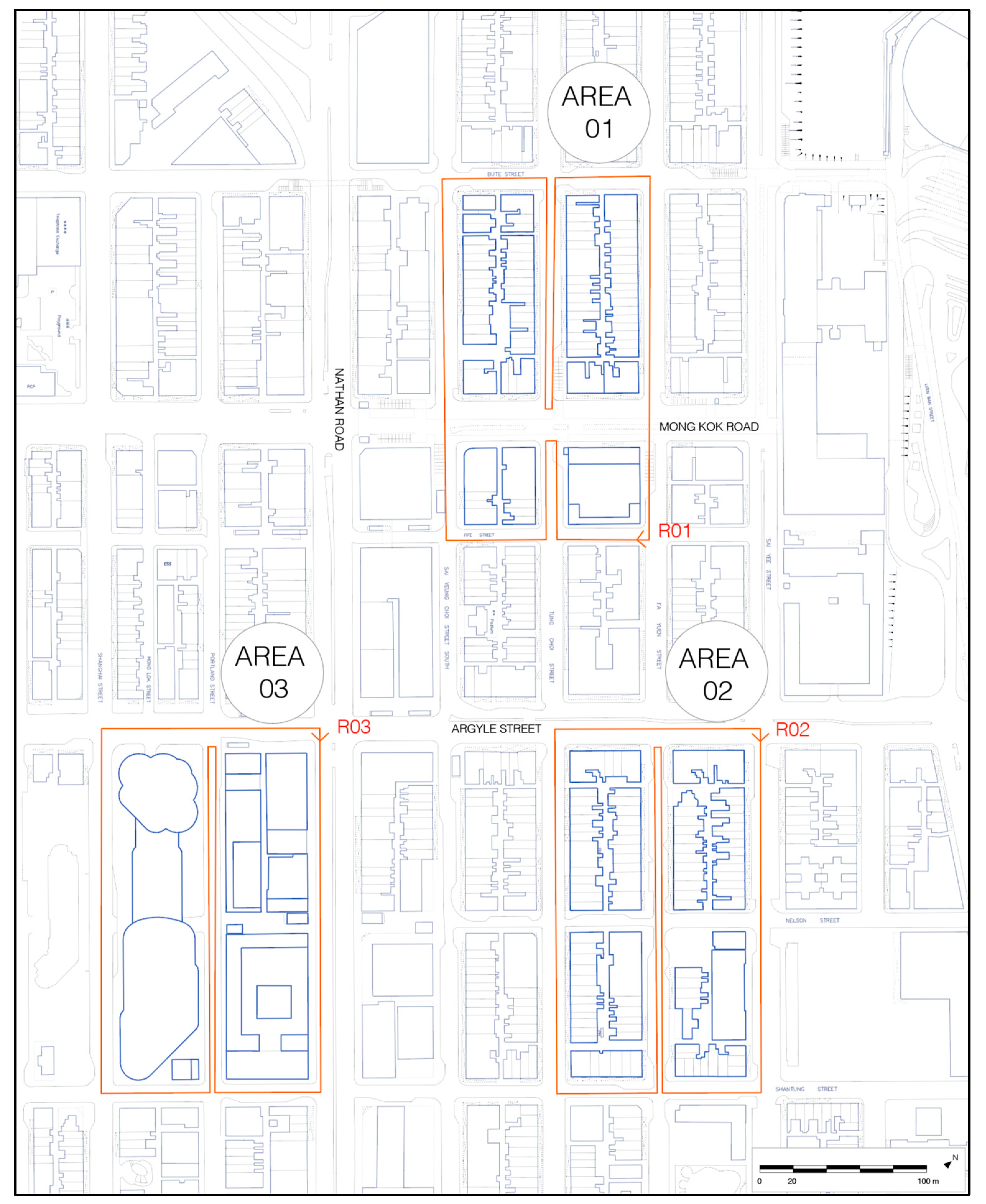
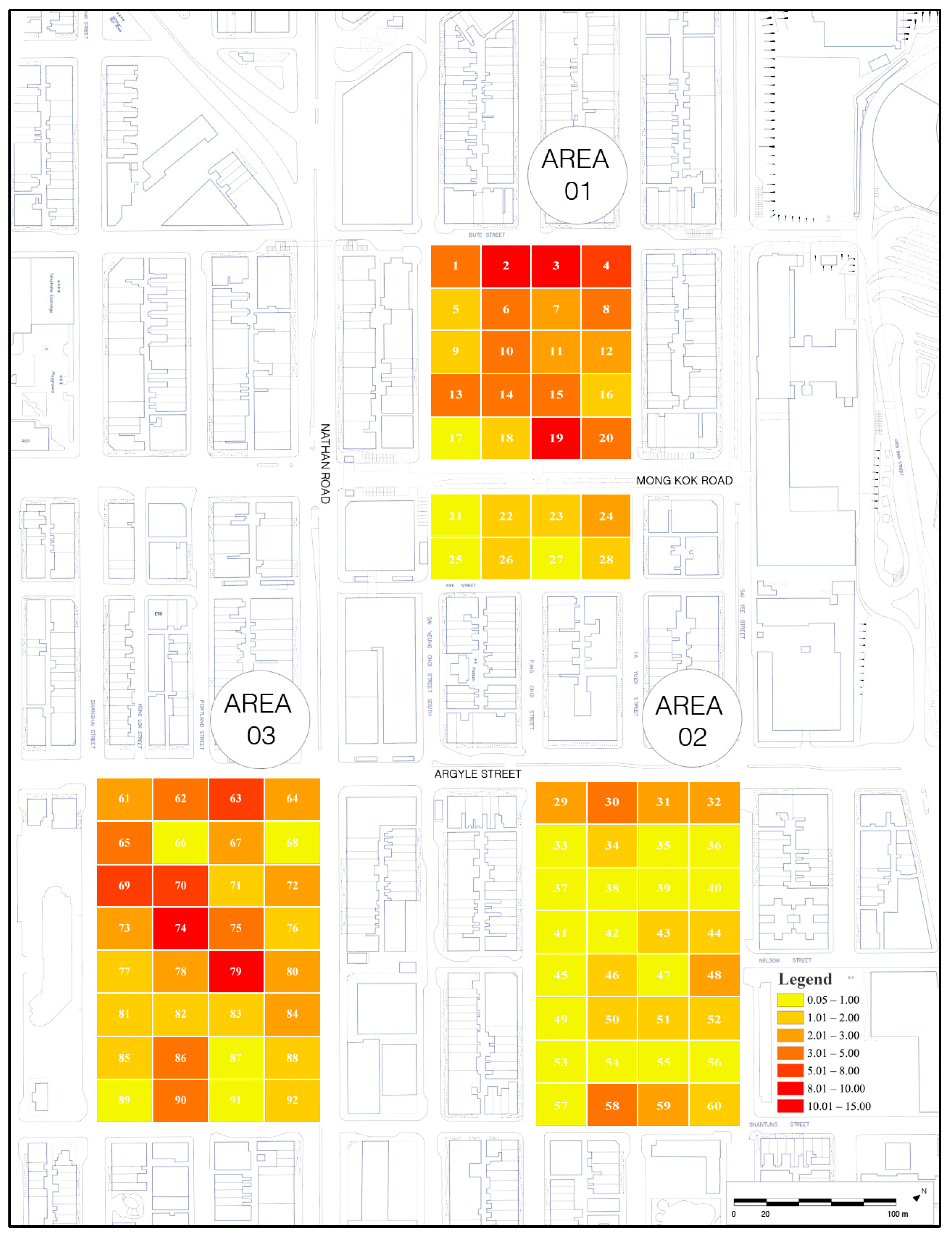
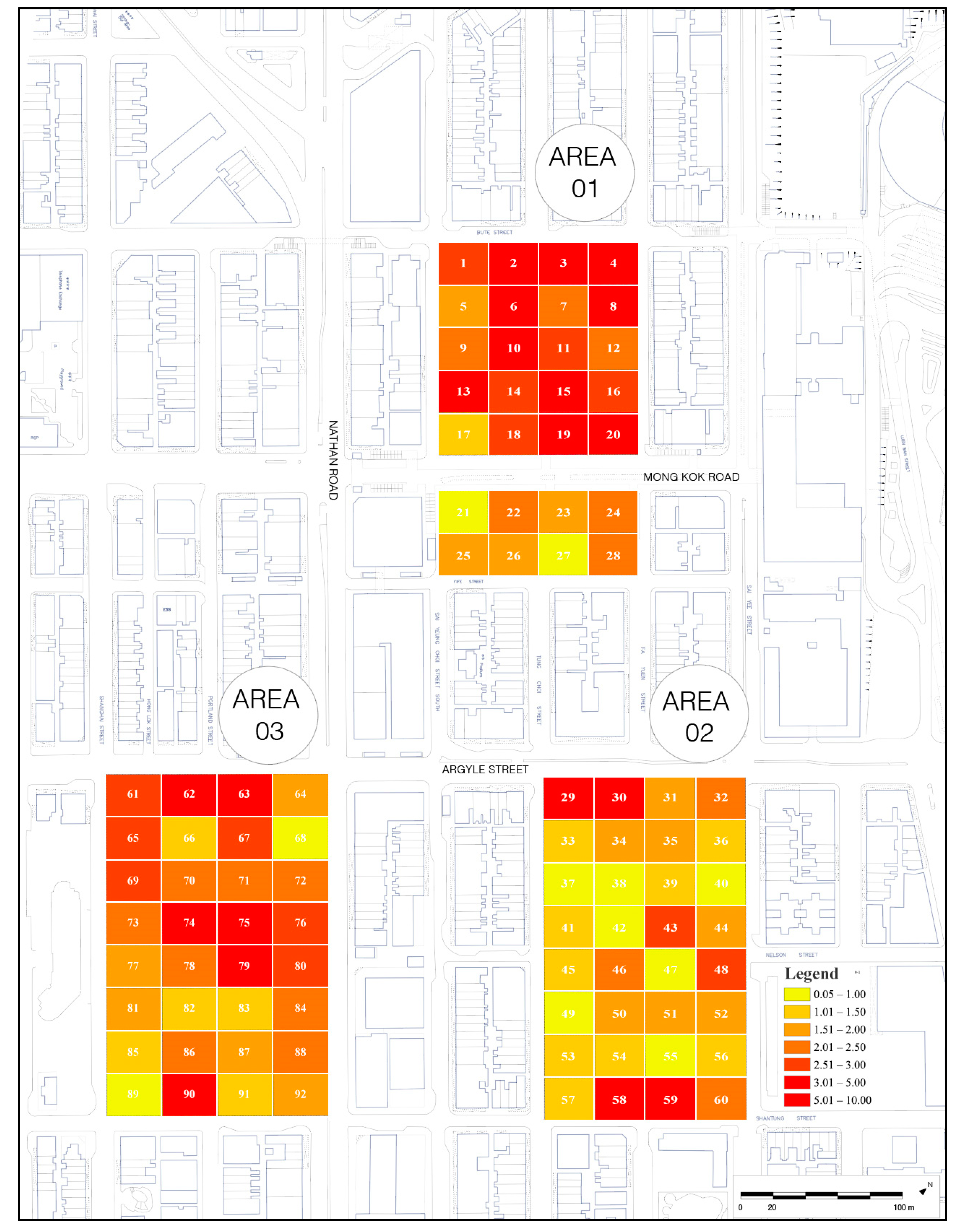
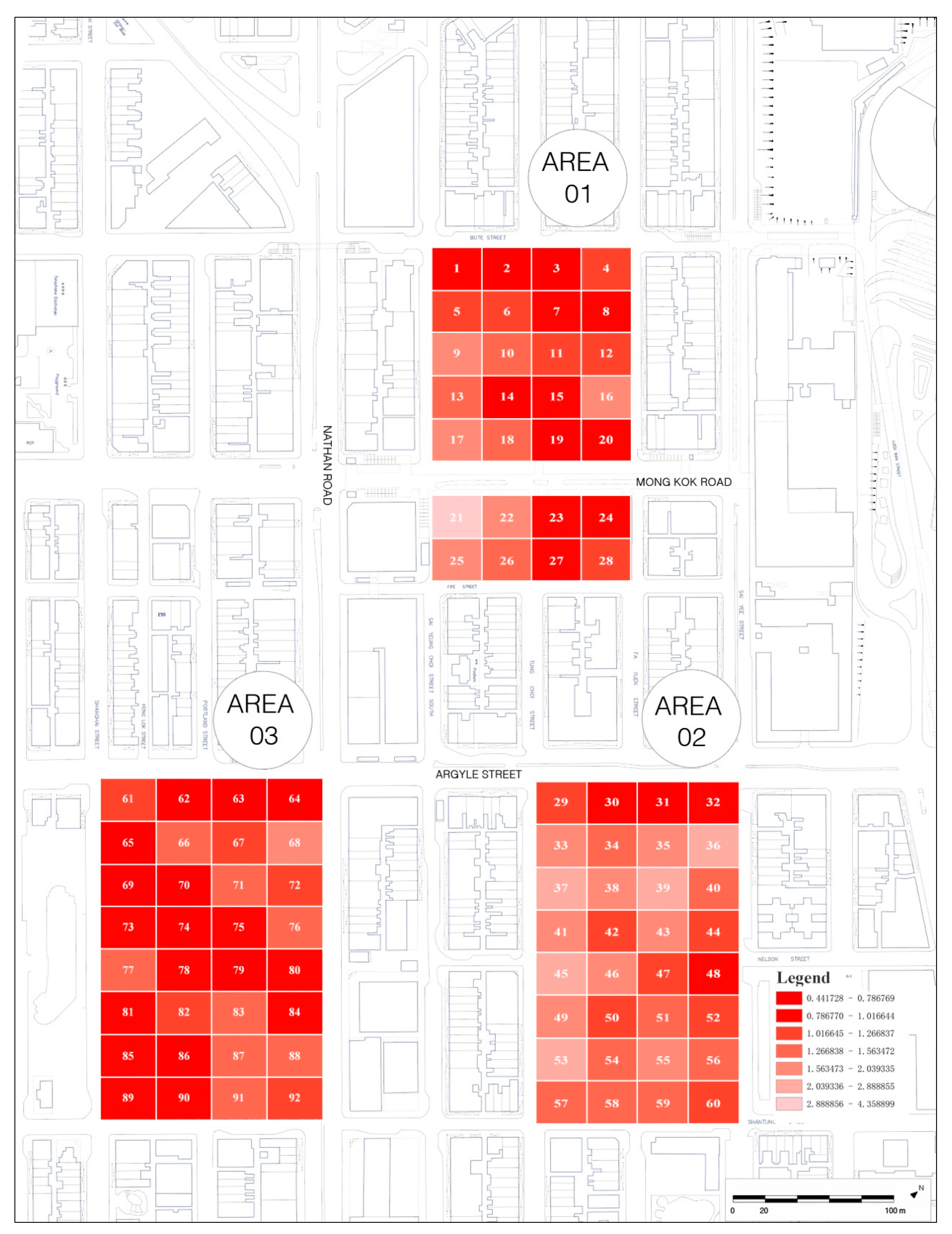

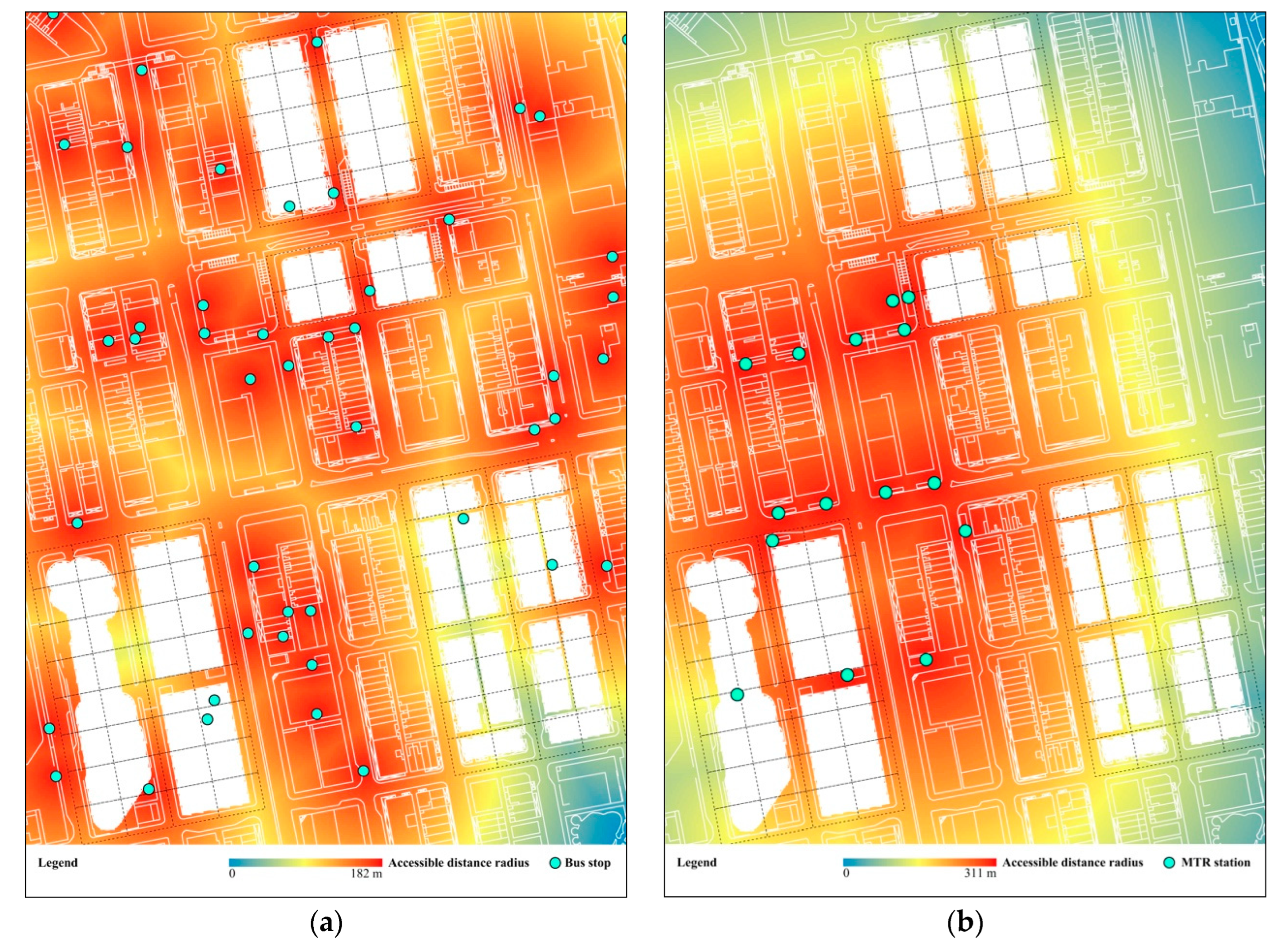
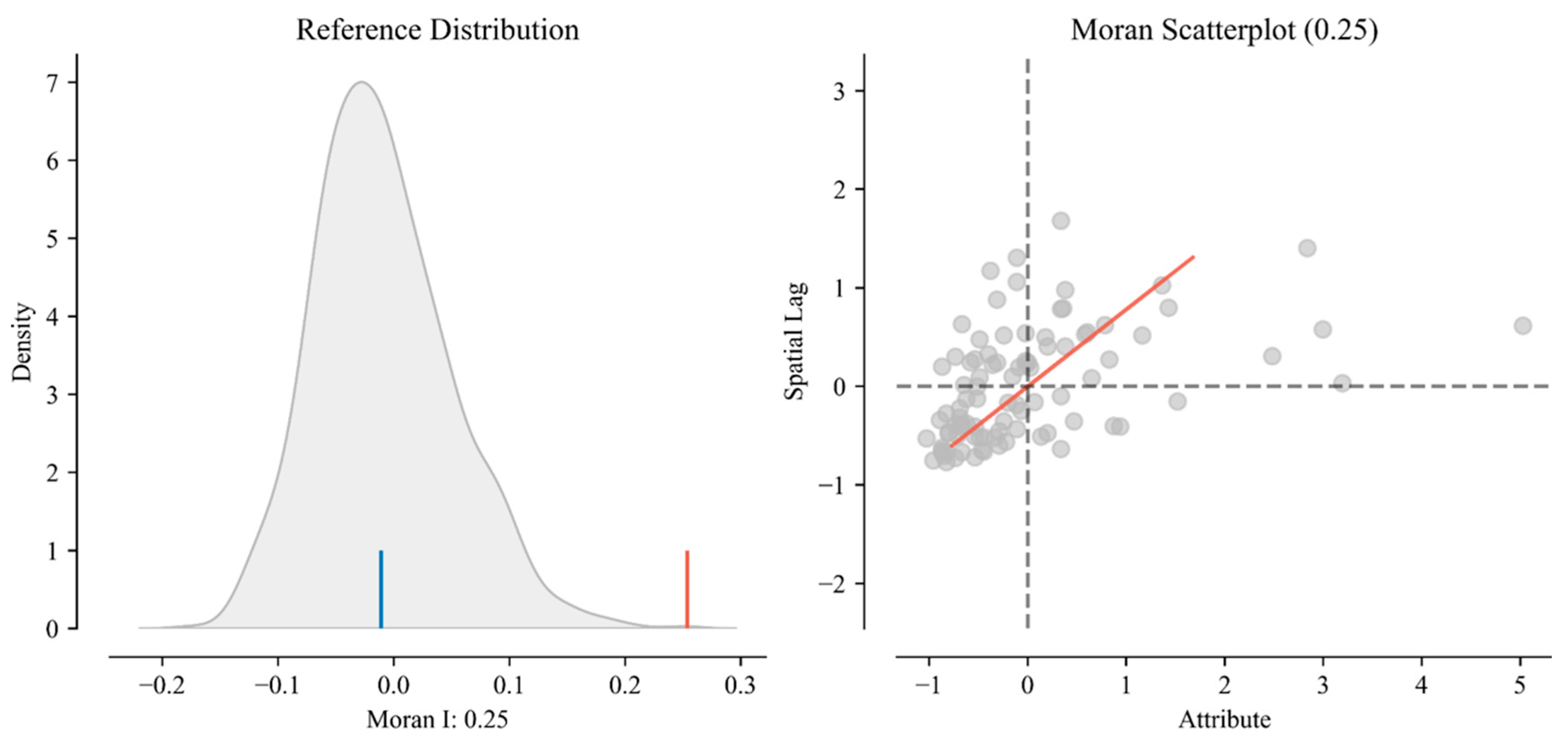
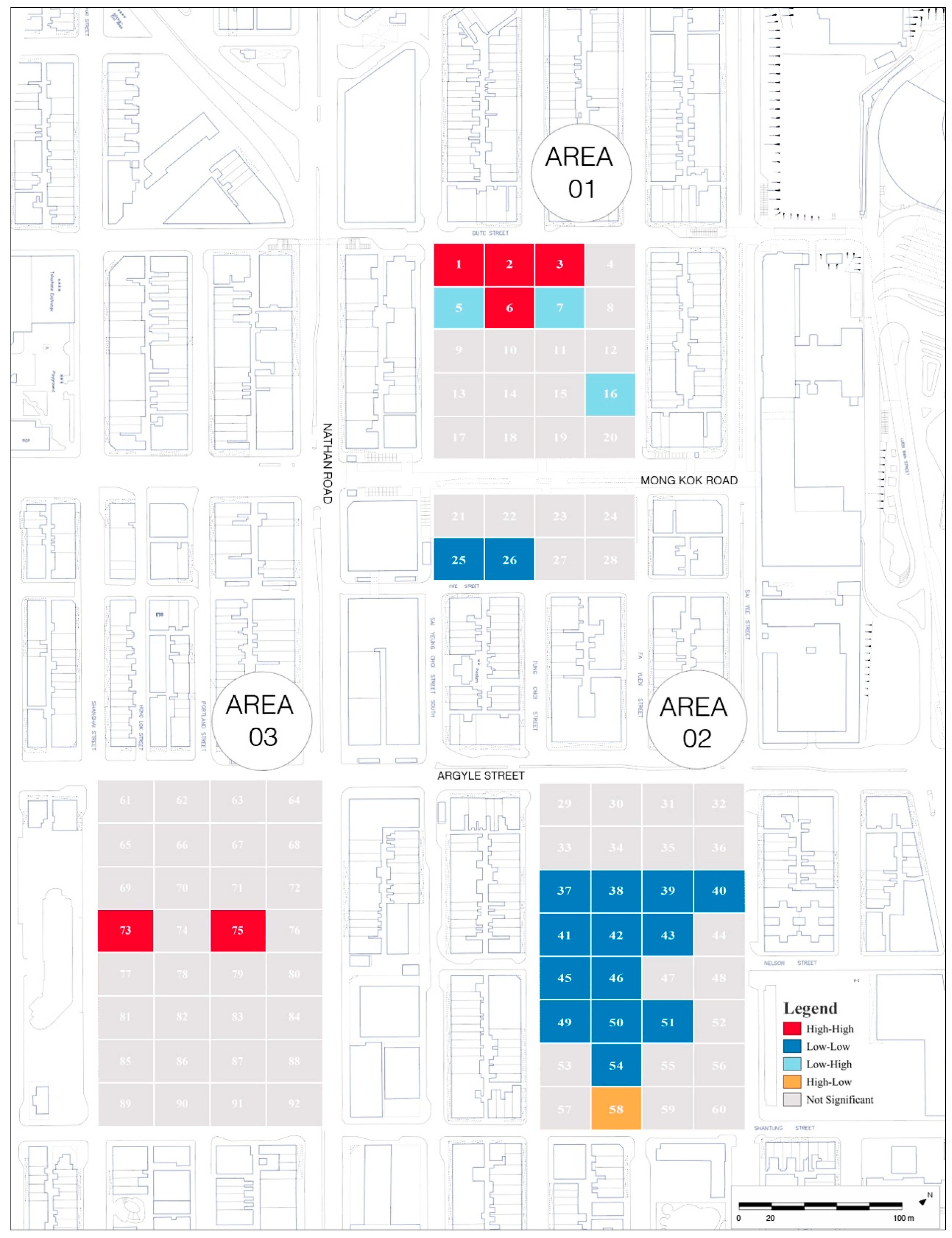
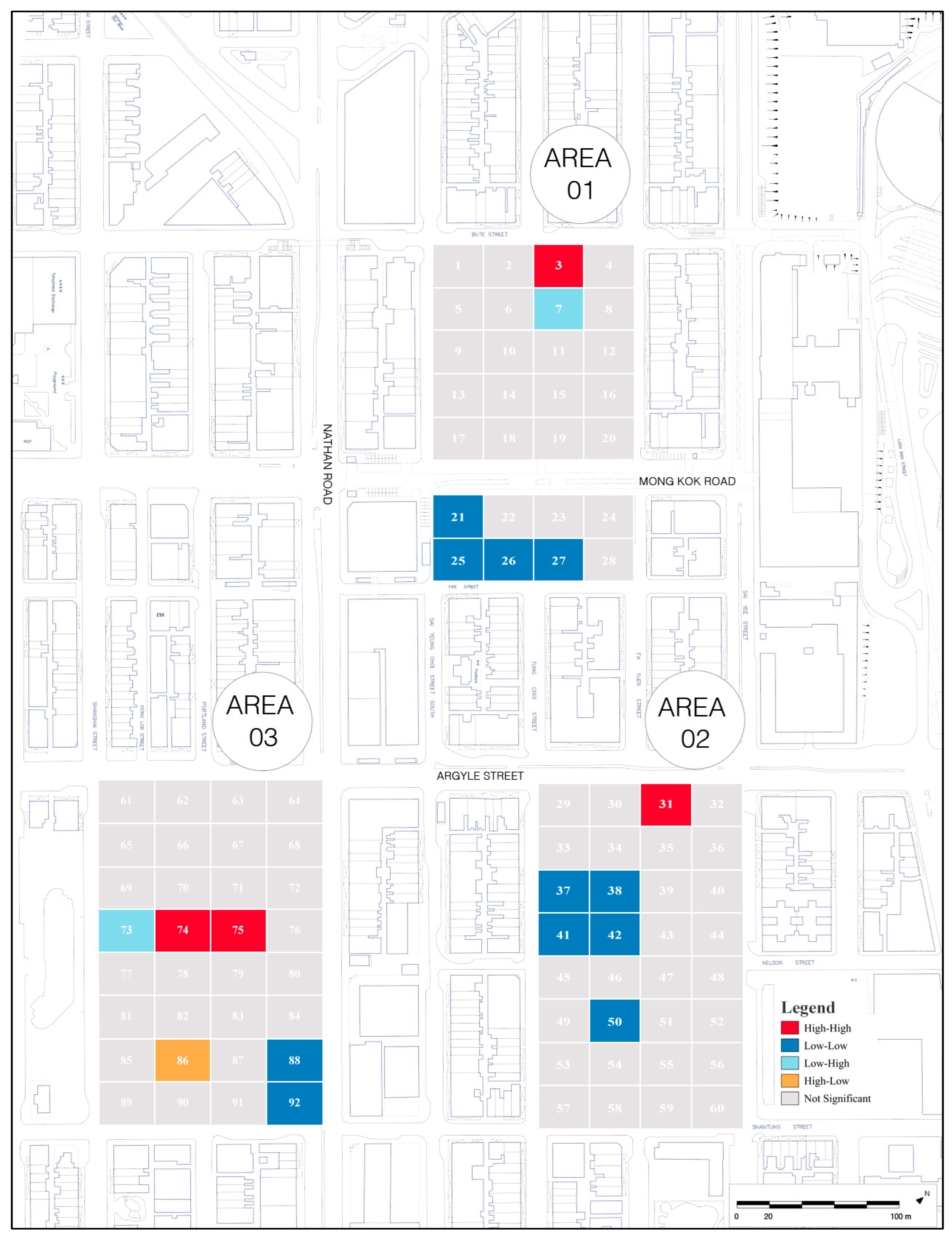
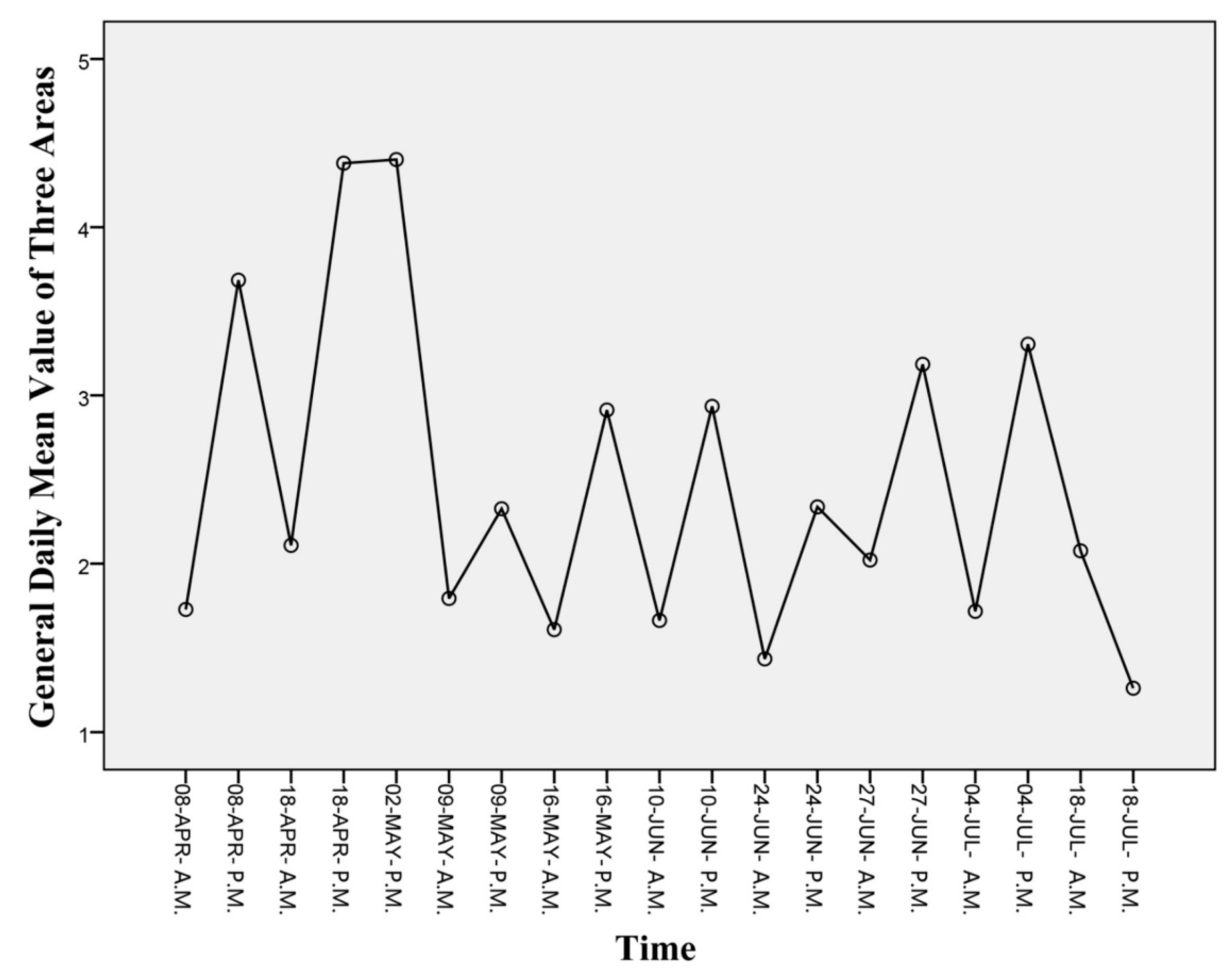

| MEAN | Dist_MTR | Dist_Bus | ||
|---|---|---|---|---|
| MEAN | Pearson Correlation | 1 | −0.016 | −0.236 * |
| Sig. (2-tailed) | 0.883 | 0.023 | ||
| N | 92 | 92 | 92 | |
| Dist_MTR | Pearson Correlation | −0.016 | 1 | 0.235 * |
| Sig. (2-tailed) | 0.883 | 0.024 | ||
| N | 92 | 92 | 92 | |
| Dist_Bus | Pearson Correlation | −0.236 * | 0.235 * | 1 |
| Sig. (2-tailed) | 0.023 | 0.024 | ||
| N | 92 | 92 | 92 | |
| Sum of Squares | df | Mean Square | F | Sig. | Partial Eta Squared | Noncent. Parameter | Observed Power a | |
|---|---|---|---|---|---|---|---|---|
| Contrast | 1758.989 | 18 | 97.722 | 6.965 | 0.000 | 0.068 | 125.378 | 1.000 |
| Error | 24,256.957 | 1729 | 14.029 |
| Area | R | R2 | Adjusted R2 | Std. Error of the Estimate | Change Statistics | Durbin–Watson | ||||
|---|---|---|---|---|---|---|---|---|---|---|
| R2 Change | F Change | df1 | df2 | Sig. F Change | ||||||
| 01 | 0.931 a | 0.867 | 0.859 | 0.702260534823448 | 0.867 | 110.520 | 1 | 17 | 0.000 | 1.857 |
| 02 | 0.786 a | 0.618 | 0.596 | 0.51355464 | 0.618 | 27.554 | 1 | 17 | 0.000 | 1.866 |
| 03 | 0.214 a | 0.046 | −0.011 | 0.66402659 | 0.046 | 0.813 | 1 | 17 | 0.000 | 1.918 |
| Model | Unstandardized Coefficients | Standardized Coefficients | t | Sig. | 95.0% Confidence Interval for B | |||
|---|---|---|---|---|---|---|---|---|
| B | Std. Error | Beta | Lower Bound | Upper Bound | ||||
| 1 | (Constant) | 0.366 | 0.321 | 1.138 | 0.271 | −0.312 | 1.043 | |
| Area 01 | 0.629 | 0.060 | 0.931 | 10.513 | 0.000 | 0.503 | 0.756 | |
| 2 | (Constant) | 0.579 | 0.185 | 0.786 | 3.132 | 0.006 | 0.189 | 0.968 |
| Area 02 | 0.946 | 0.180 | 5.249 | 0.000 | 0.566 | 1.327 | ||
| 3 | (Constant) | 2.673 | 0.286 | 0.214 | 9.329 | 0.000 | 2.068 | 3.277 |
| Area 03 | 0.079 | 0.088 | 0.902 | 0.380 | −0.106 | 0.264 | ||
| Target | Data Analysis | Results | Design Direction |
|---|---|---|---|
| Activity density dispersion | SD and CV | Highest SD values in A01. A02 with SD below 2.5. | Parcel as a cluster (intermediate scale) planning approach for design and analysis. |
| Accessibility MTR and Bus | Pearson Correlation | Majority of red areas corresponding to regions with high SD values. | Parcel as a cluster (intermediate scale) planning approach for design and analysis. |
| Spatial Association | Moran | Average pedestrian quantity in different parcels remained stable in magnitude and spatial distribution pattern, with no significant changes observed in the expected values (E(I)) and a significant p-value (p < 0.05), indicating a clustered tendency. | Parcel as a cluster (intermediate scale) planning approach for design and analysis. |
| LISA | No. 1, 2, 3, and 6 in A01, and No. 73 and 75 in A03 have a significant impact on surroundings; majority of low-low in A02. | Street interface spatial design for controllable and multilevel human environment interactions (materials and design guidelines). Addition of cognitive and affective elements within the design strategy. | |
| ANOVA and post hoc test | The numerator degree of freedom (v1) is 18, and the denominator degree of freedom (v2) is 1729, with an F-value of 6.965 and a significance value, which is less than 0.05. The p-values for Area 01 and Area 02 were statistically significant, whereas the p-value for Area 03 was 0.38, which was greater than 0.05, indicating that the regression coefficient was not statistically significant and there was no linear correlation between the dependent and independent variables. | Podium-tower urban block morphologically questioned. Design for interaction approach (integration of decision-making and behavioral perspectives within design strategy). |
Disclaimer/Publisher’s Note: The statements, opinions and data contained in all publications are solely those of the individual author(s) and contributor(s) and not of MDPI and/or the editor(s). MDPI and/or the editor(s) disclaim responsibility for any injury to people or property resulting from any ideas, methods, instructions or products referred to in the content. |
© 2023 by the authors. Licensee MDPI, Basel, Switzerland. This article is an open access article distributed under the terms and conditions of the Creative Commons Attribution (CC BY) license (https://creativecommons.org/licenses/by/4.0/).
Share and Cite
Zordan, M.; Tsou, J.Y.; Huang, H. Street Vibrancy and Outdoor Activities under COVID-19 Psychological Distress: Lessons from Hong Kong. Land 2023, 12, 1896. https://doi.org/10.3390/land12101896
Zordan M, Tsou JY, Huang H. Street Vibrancy and Outdoor Activities under COVID-19 Psychological Distress: Lessons from Hong Kong. Land. 2023; 12(10):1896. https://doi.org/10.3390/land12101896
Chicago/Turabian StyleZordan, Mirna, Jin Yeu Tsou, and Hao Huang. 2023. "Street Vibrancy and Outdoor Activities under COVID-19 Psychological Distress: Lessons from Hong Kong" Land 12, no. 10: 1896. https://doi.org/10.3390/land12101896
APA StyleZordan, M., Tsou, J. Y., & Huang, H. (2023). Street Vibrancy and Outdoor Activities under COVID-19 Psychological Distress: Lessons from Hong Kong. Land, 12(10), 1896. https://doi.org/10.3390/land12101896









